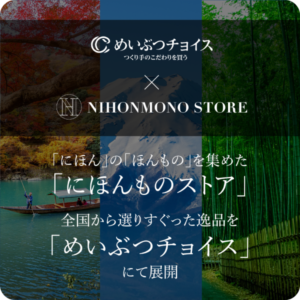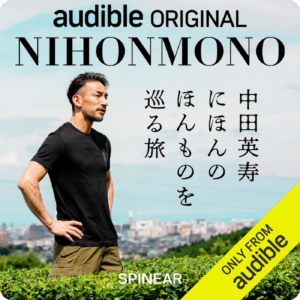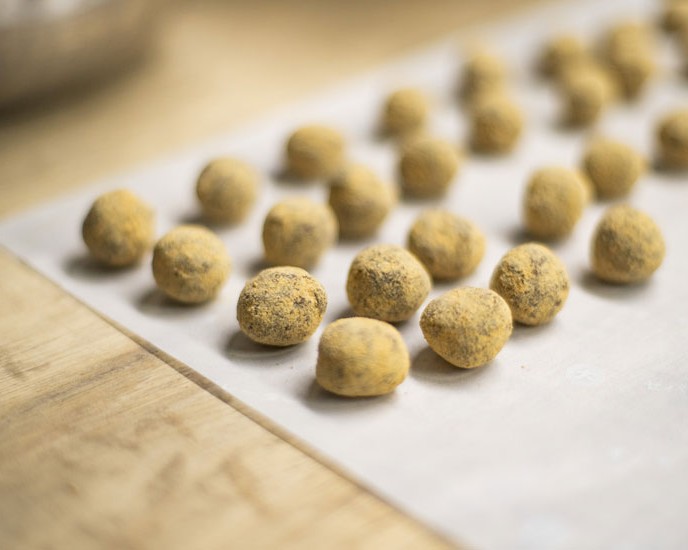In Nanao City, Ishikawa Prefecture, there is a traditional confectionery that has been passed down since the Kamakura period. It is a Japanese confectionery called “mameame” made from soy flour and starch syrup. It has been loved for generations, but in recent years, people have become less interested in Japanese confectioneries in general, and even in the local area, there are more and more people who don’t know about mameame. In order to change this situation, the students of the Japanese confectionery store “Umeya Tsune-goro” and “Otori Gakuen High School” have started a new challenge.
The history of “soy bean candy” dates back to the Kamakura period.

The name “mameame” is written with the kanji for “soybean” and “candy”. This Japanese confectionery has been handed down in Nanao City, Ishikawa Prefecture, for a long time, and is popular for its simple taste, made by kneading soy flour and starch syrup together. The chewy texture and the savory flavor of the soybeans spread through your mouth with a sense of nostalgia, and you can’t help but smile.
Even though it’s been around for a long time, it’s not a hundred or two hundred years old. There is a record that Nobutsura Hasebe, a military commander who ruled over Noto Province (northern Ishikawa Prefecture, including the present-day city of Nanao) during the Kamakura period (approx. 800 years ago), presented soy bean candy to his lord, Minamoto no Yoritomo. It is also said that Toshiie Maeda, a military commander based in Nanao during the Azuchi-Momoyama period, entertained Toyotomi Hideyoshi with soy bean candy, which shows how long it has been rooted in this area.
Because of its high nutritional value and long shelf life, it was also said to have been a valuable emergency food for the Kitamae boats that traveled the Sea of Japan from the Edo period to the early Meiji period.
Umeya Jyogoro, which produces the traditional Nanao confectionery, soy bean candy

Located in the center of the Noto Peninsula, the city of Nanao has long prospered as the political and economic center of Noto. In the Muromachi period, the Hatakeyama clan, a group of provincial feudal lords, built a castle town, and in the Azuchi-Momoyama period, Maeda Toshiie built another castle town, and the area prospered greatly. Against this backdrop, the tea ceremony culture flourished, and Japanese sweets also became popular. Umeya Jyogoro, a Japanese sweets shop established in 1915, is one of the shops that has helped to spread the culture of Japanese sweets in Nanao.

The fourth generation, Masakuni Miyagawa, honed his skills as a Japanese confectioner and took over the shop from his father in 2020. The shop’s signature product is soy candy. As the times have changed, the number of shops making soy candy has decreased, but Miyagawa has faithfully preserved the ingredients and production methods that have been passed down through the generations, and has continued to pass on the traditional taste of Nanao.
At the same time, he also had this thought: “Most of the people who buy soy candy are elderly. When it comes to the younger generation, there are many people who have never seen or eaten soy candy before. How can we get young people to buy soy candy?” His feelings wavered between the dwindling tradition and the needs of the times. At that time, he received an offer from a local high school student: “I want you to make a new kind of soy candy with me.”
A challenge for high school students who were not familiar with soy candy

The students of the Hōgaku High School in Nanao City asked Mr. Miyagawa for his cooperation. Hōgaku is known for its liberal school culture, and it is the only high school in Ishikawa Prefecture with a culinary arts department.
As part of their research activities, one group focused on soy bean candy. “It’s said to be a traditional Nanao confection, but the younger generation doesn’t know much about it, and they’ve never eaten it.” This was the same feeling as Mr. Miyagawa.
What we can do to keep the tradition alive

In order to find out how well soy candy was known, the students conducted a questionnaire survey of 5th and 6th grade elementary school students and 1st to 3rd grade junior high school students in Nanao City. The results showed that 92% of the students had never heard of soy candy. The students felt a sense of crisis, thinking that “if things continue like this, the long history of soy candy may come to an end”.
In order to make soy candy known to the younger generation, they thought that a new approach would be necessary. The students decided to ask Mr. Miyagawa for his cooperation in developing a new type of soy candy.
The goal of the development was to “create a new soy candy with a new flavor that would be accepted by the younger generation”. They therefore sent a letter to Hidetoshi Nakata, who is also involved in regional revitalization, and asked him to supervise the project. They hoped to create a new soy candy that had never been seen before, drawing on Nakata’s knowledge and experience of developing products for many companies.
Product development began under the supervision of Hidetoshi Nakata.

While Miyagawa-san, the students and Nakata-san held a series of online meetings and exchanged emails, the trial and error process of developing a new soy candy began. They repeated the process of making prototypes while addressing each issue one by one, such as “making the texture more enjoyable”, “what ingredients would be suitable for accentuating the flavor”, and “making it a more convenient size to eat”. No one compromised, and the flavor was refined more and more as they continued to make improvements.
For Mr. Miyagawa, both Mr. Nakata’s ideas and the students’ ideas were full of freshness that broke down stereotypes. “There were some ideas that I never would have thought of, and some unique requests. There were some difficulties in incorporating everyone’s opinions, but as a craftsman, I felt a sense of fulfillment,” he says with a smile. Above all, Mr. Miyagawa felt great joy in the process of seeing the product become tastier with each new prototype.
Meanwhile, the students were learning from their interactions with Mr. Nakata that taste was not the only thing that was important in product development. There were many things to do, such as deciding on the product concept and price, designing the packaging, naming the product, and creating a sales strategy. The product was not finished when it was completed. They continued to seek ways to make the product something that many people would want to buy and continue to sell, with Mr. Nakata’s advice.
After about five months, the soy candy with a modern twist was completed.

The target audience was women in their 30s who were keen to travel. We decided to use chocolate to add a modern essence to the soy candy, while sticking to locally-produced ingredients as much as possible.
The most creative part was expressing the texture and flavor. To bring out the toasty aroma of the soy flour, we ground the soy beans in the store to maintain freshness. We added nuts to the dough, which we had made to be as soft as earlobes, so that people could enjoy the contrast in texture. The nuts used are walnuts, almonds and hazelnuts, which have different flavors. They are baked in the oven, crushed into small pieces, covered in caramel and then coated in chocolate to give them a rich flavor.
The salt and soy sauce from Noto were chosen as accents to bring out the overall flavor. The time and effort that went into making the handmade soy candy has resulted in a taste that makes you want to reach for another piece.
The hopes for the recovery of Noto are carried in the new soy candy.

In fact, the students’ inquiry activities had another theme: the desire to “cheer up” Nanao City, which was badly damaged by the Noto Peninsula earthquake in 2024. Many buildings collapsed in Nanao City, and the school building of Hōgakuin also sustained serious damage, including subsidence and cracks in the outer walls. Many people are still living in secondary evacuation centers or temporary housing, and the city and its people are still in the process of recovery from the damage.

The name of the newly developed soy candy was decided to be “FUCCO (Fukkou: Revival)” with the wish that “it will be a step towards revival and that the people who buy it will receive good fortune”. In addition to selling it at the Umeya Tsune-Goro store and Kanazawa Station, they have also secured internet sales and sales through the “furusato nozei” tax system so that as many people as possible across the country can get their hands on it. A portion of the sales will be donated to Nanao City as a contribution to the recovery effort.
The reborn soy candy is a symbol of the town’s future.

The students are determined to “change the year 2024 from the year of the earthquake to the first year of recovery”. Just as they have expressed the tradition of soy bean candy in a new way, they hope that the city of Nanao will also be able to recover in a positive way. Their thoughts about the future of their beloved hometown are straightforward, unpretentious and light.
The pride of having continued a tradition for 800 years will be the driving force of recovery.

Mr. Miyagawa said that he gained a lot of insight into the sensibilities of the younger generation. Preserving tradition means “connecting with the past”. “While it may be one way to adapt the traditional recipe for soy candy to suit the times, I think that continuing to have exchanges like this will also lead to the continuation of tradition”. Mr. Miyagawa’s goal is to continue to pass on the traditional sweets that are the pride of Nanao to future generations, while expanding new exchanges and perspectives.
For the students, tracing the history of soy candy was also tracing the history of Nanao. They felt a sense of pride in the fact that the soy candy eaten by Minamoto no Yoritomo in the Kamakura period, the soy candy that Miyagawa-san has inherited, and the new soy candy they developed were all connected by a single line. Her eyes lit up as she said, “It’s amazing that it’s been passed down for 800 years. It’s got so much potential.”
In Nanao City, where the scars of the earthquake are still visible here and there, this joint development project was undertaken by a long-established Japanese confectionery store and local high school students. FUCCO, which was born from the connection formed through soy bean candy, carries the hopes for recovery to the city of Nanao and then spreads throughout the whole country.
To “preserve tradition” is to “connect with the past”. Both Miyagawa and the students hope that FUCCO, a traditional confection made with thoughts of home in mind, will become a new traditional confection that overwrites the hopes of the damaged city of Nanao.



